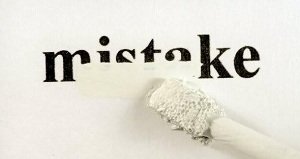
Here are 10 mistakes students make most often.
- The man which lives in this house is from Italy – when you speak about an animate being you should use who;
- Fewer and less. The former is used when you speak about countable objects (I have 5 fewer pencils), the latter is used when you speak about uncountable concepts (You have less than a day);
- Than and then. You would be amazed how many people make this mistake. Than is used in comparisons (He is smarter than most of his friends), then is used in reference to time (He was at home until noon, then he went for a walk);
- Its and it’s. It is a rather tricky matter. Usually the apostrophe means possession (student’s pencil), but it is also used in short forms of some expressions (don’t, doesn’t). That’s why its and it’s may be confusing. If it is a shortened form of it is, use it’s (it’s snowing), if you need a possessive pronoun, use its (its distinctive features);
- Irregular verbs. Of course there is not enough space here to enumerate them all, so make sure to learn them by heart. Otherwise you are in for quite a few nasty surprises.
- Absence of subject/verb agreement. Subjects and verbs should agree in number. It may sound obvious, but many people make this mistake in longer sentences;
- Nor and or. It is rather simple. Nor is used before the second variant in sentences where neither introduces the first. Or is used before the second variant where either introduces the first (neither he nor I, either he or I);
- Lie and lay. You lay something. Then something liesall by itself.
- Wrong or missing verb endings. –s and –es, -d and –ed. It may be easy to miss them because they are often pronounced indistinctly.
- Whether and if. Contrary to popular belief, these two words aren’t interchangeable. Whether is used when there are two or more alternatives. If is used when there are no alternatives. I don’t know whether to go or not. I can go there if I have any time.
